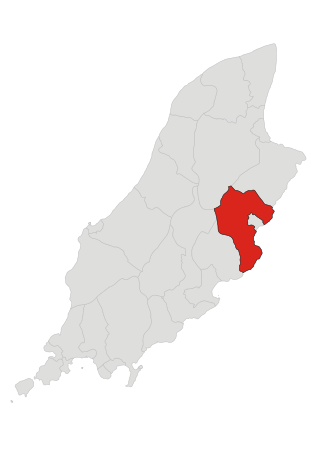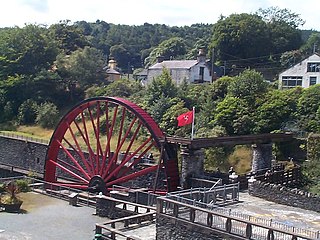
The Isle of Man is an island in the Irish Sea, between Great Britain and Ireland in Northern Europe, with a population of almost 85,000. It is a British Crown dependency. It has a small islet, the Calf of Man, to its south. It is located at 54°15′N4°30′W.

Laxey is a village on the east coast of the Isle of Man. Its name derives from the Old Norse Laxa meaning 'Salmon River'. Its key distinguishing features are its three working vintage railways and the largest working waterwheel in the world. It is also the location of King Orry's Grave.

The Laxey Wheel is built into the hillside above the village of Laxey in the Isle of Man. It is the largest surviving original working waterwheel in the world. Designed by Robert Casement, the wheel has a 72-foot-6-inch (22.1 m) diameter, is 6 feet (1.8 m) wide and revolves approximately three times per minute.

Bagillt is a large village and community in Flintshire, Wales. The village overlooks the Dee Estuary and is between the towns of Holywell and Flint. At the 2001 Census the population was recorded as 3,918, increasing to 4,165 at the 2011 census. The community also includes the settlements of Coleshill, Walwen and Whelston.

Manx National Heritage is the national heritage organisation for the Isle of Man. The organisation manages a significant proportion of the island’s physical heritage assets including over 3,000 acres of coastline and landscape. It holds property, archives, artwork, library and museum collections in trust for the Manx nation. It is the Isle of Man's statutory heritage agency and an Isle of Man registered charity (№ 603).

The Great Laxey Mine Railway was originally constructed to serve the Isle of Man's Great Laxey Mine, a lead mine located in Laxey. The 19 in gauge railway runs from the old mine entrance to the washing floors along a right of way that passes through the Isle of Man's only remaining railway tunnel under the 3 ft gauge Victorian Manx Electric Railway and the main A2 Douglas to Ramsey coast road.

Lonan is one of the 17 parishes of the Isle of Man.

The Snaefell Wheel is a waterwheel in Laxey, Isle of Man. The wheel stands in the washing floors in Laxey Glen Gardens, approximately 700 metres south of the larger Laxey Wheel.

The Great Snaefell Mine, also referred to as the East Snaefell Mine, was a zinc mine located high in the Laxey Valley on the slopes of Snaefell Mountain, in the parish of Lonan, Isle of Man. The mine reached a depth of 1,188 ft (362 m) and is remembered as the scene of the Isle of Man's worst mining disaster in 1897.
The Great Snaefell Mining Company was a mining company formed to operate the Great Snaefell Mine on the Isle of Man.

The Great Laxey Mine was a silver, lead ore and zinc mine located in Laxey, in the parish of Lonan, Isle of Man. The mine reached a depth in excess of 2,200 ft (670 m) and consisted primarily of three shafts: the Welsh Shaft, the Dumbell's Shaft and the Engine Shaft; each of these shafts was connected by a series of levels.
The Isle of Man Mining Company, also referred to as the Foxdale Mining Company, was a mining company formed to operate the Foxdale Mines on the Isle of Man.
The Ballajora Mine also referred to as the Maughold Head Mine, was an iron ore, hematite and copper mine located in the parish of Maughold, Isle of Man. The mine lay principally on the farmland of Magher-beck. The head engineer of the mine, referred to as the Mine Captain, was John Faragher.
The Maughold Head Mine was a copper mine located in the parish of Maughold, Isle of Man.
The Maughold Head Mining Company was a mining company formed to explorate around the area of Maughold Head on the Isle of Man. The company's registered offices were at 30, John St, Bedford Row, London.

William Henry Kitto was Captain of the Foxdale Mines, vice-chairman of the Isle of Man Steam Packet Company, a director of the Isle of Man Railway and a Justice of the Peace who became a Member of the House of Keys for the constituency of Glenfaba in 1902.

The Foxdale Mines is a collective term for a series of mines and shafts which were situated in a highly mineralised zone on the Isle of Man, running east to west, from Elerslie mine in Crosby to Niarbyl on the coast near Dalby. In the 19th century the mines were widely regarded as amongst the richest ore mines in the British Isles.

John Kewley was Captain of the Great Snaefell Mine, Isle of Man. He is remembered for his heroism following the Snaefell Mine Disaster of 1897, during which he displayed extraordinary courage and endurance and for which he received the Medal of the Honourable Order of the Knights of St John of Jerusalem.
The geology of the Isle of Man consists primarily of a thick pile of sedimentary rocks dating from the Ordovician period, together with smaller areas of later sedimentary and extrusive igneous strata. The older strata was folded and faulted during the Caledonian and Acadian orogenies The bedrock is overlain by a range of glacial and post-glacial deposits. Igneous intrusions in the form of dykes and plutons are common, some associated with mineralisation which spawned a minor metal mining industry.

Agneash is a small village in the Isle of Man, 1.9 kilometres (1.2 mi) by road north of Laxey. Agneash Primitive Methodist Chapel opened in 1857.














